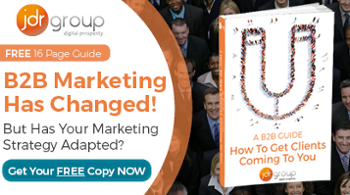How To Use An Effective Business-To-Business (B2B) Marketing Strategy To Generate More Leads

In selling products and services to other businesses, marketing has always been different from consumer products and services. Unlike consumer products, most business to business companies have longer sales cycles which involve several stakeholders and complex quotations.
The old model has generally been in three parts: generate leads with marketing, and then have your sales team nurture those relationships, and ultimately close sales. Leads would be generated by trade shows and exhibitions, cold calling, direct mail, e-shots, and possibly trade advertising.
Business To Business (B2B) Marketing Strategy in The Digital Age
In 2021 however, sales and marketing has changed. The digital age has meant that buyers have changed, they now have access to more information than ever before and are more in control of the sales process as a result – they can find out any information they want, when and where they want to do it.
The digital age has also changed sales and marketing, we can now identify and research potential customers quicker than ever before, and we have CRM systems and marketing automation software to help organise and leverage our sales and marketing efforts.
In this new age we are living in, a modern marketing strategy involves inbound marketing - letting buyers find and discover you online, educating them with interesting and useful content and nurturing them with marketing automation.
Sounds easy, right?
Well, not as easy as it sounds. In fact, we speak to business owners and marketers on a daily basis who have and/or are trying to implement digital marketing and are not achieving the results they want. So what is the problem?
Often, it is to do with implementation, and how campaigns are executed, but more often than not it is a more fundamental problem – a lack of strategy.
We all lead busy lives and are expected to achieve results straight away, so we often jump into SEO, Pay-per-click, email and social media campaigns without fully developing a clear strategy first. This means we end up on a hamster wheel – running faster and faster just to stay still.
So what goes into creating good b2b marketing strategies?
There are six key areas we focus on when working with our clients:
1. Vision – what is the vision for the business overall? And does the marketing plan align with the vision? What are the goals that need to be achieved to make the vision a reality, and how can we build our marketing plan around achieving those goals?
2. USP – is there one or more clear (and compelling) unique selling points? How can we communicate those?
3. Core Message – what are the key messages which, if fully understood by our buyers, would increase our market share and revenues?
4. Target Market – what are the most important target market segments for our business? How do we prioritise these segments?
5. Buyer Persona – beyond the market, who are the people that we sell/market to? Who are the decision makers we need to influence, and how do we profile them?
6. Buyer Journey – what is their decision making process? What are the questions or objections they have at each stage of the buying process?
Answering these questions requires deep thought and takes time to develop. Once you have these, however, every marketing decision that follows becomes easier.
You can now watch me talk through these key concepts in this short video:
5 Reasons Why Business Owners and Marketers Fail With Their Marketing Strategy
There is nothing in the list above that is new – these are solid marketing principles that have stood the test of time. So why do so many businesses fail to create this strategy?
1. Finding time/prioritising – we’re always under pressure to deliver results today, not tomorrow. It’s always easier to send another email campaign or start a new sales initiative which will have a tangible and measurable result than to spend time on strategy. If we were to start an inbound marketing campaign with you, one of the first things we’d do is to give you a tailored strategy workshop where we would block out 1-2 days to just work with you and your team to develop your strategy.
2. Pitfalls and roadblocks – there are common problems with each of the six points I gave earlier: questions, pitfalls, blind alleys, mistakes and stumbling blocks. This is where having an external facilitator can make such a difference, to help steer you through and your team through these roadblocks.
3. Achieving buy-in – inbound marketing works most effectively when the culture of inbound marketing is adopted by the whole business and where many people contribute – from the CEO/MD, senior leadership all the way down to the people at the coalface. Everyone can contribute on social media, everyone can contribute to content, and everyone can contribute ideas. Again, this is where our workshops can help get this buy-in – by involving people beyond the marketing team and ensuring everyone is working towards the same goals.
4. Aligning strategy with business objectives – the goal of the marketing director is not always the same as the goal of the CEO, and it’s vital that the marketing team do not just chase the short term numbers but invest in the long term of the business by building authority, trust, and by building a long term marketing pipeline.
5. Implementation – it’s one thing developing the strategy but inbound marketing requires a wide range of skills including design, search engine optimisation, copywriting, PR, Google AdWords management, project management, analytics and analysis, coding/development and much more. Some businesses have all of these skills in-house, but for small marketing teams it makes more sense to hire an agency like ours to implement the strategy.
To find out more about developing a winning B2B marketing strategy, and to discover a six-step process to implementing it as well as more information about how JDR Group can help you download our new eBook: ‘How To Get Customers Coming To You, Qualified & Ready To Buy’
NOTE!
We have also recorded a podcast on this subject - listen below, and subscribe for free on iTunes, Souncloud or Stitcher.




